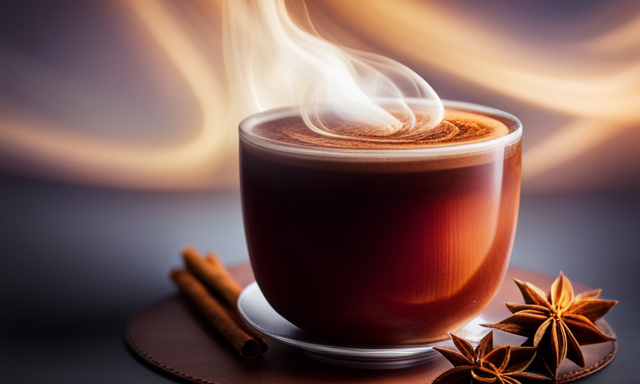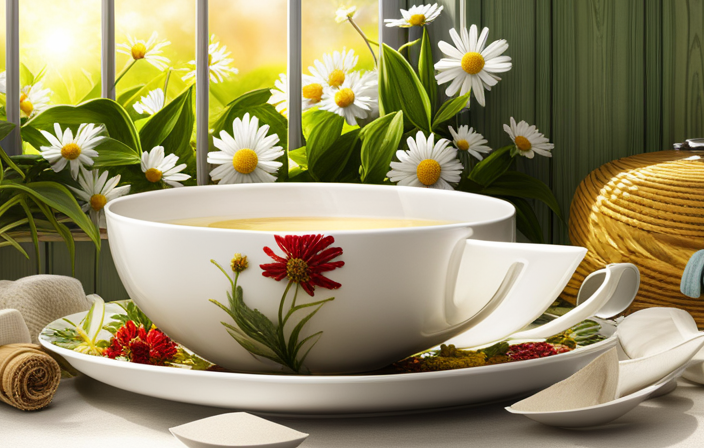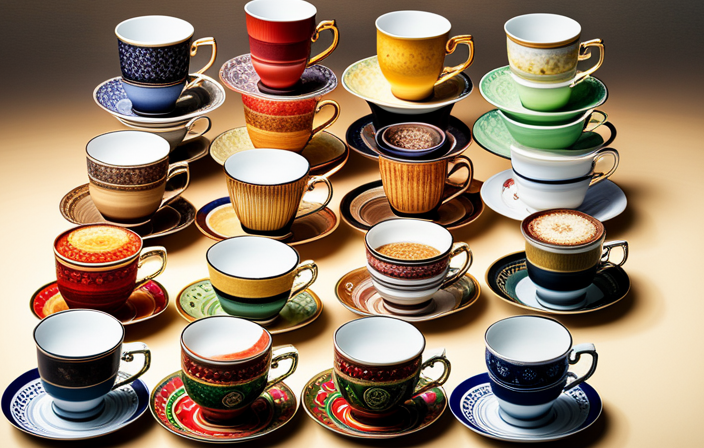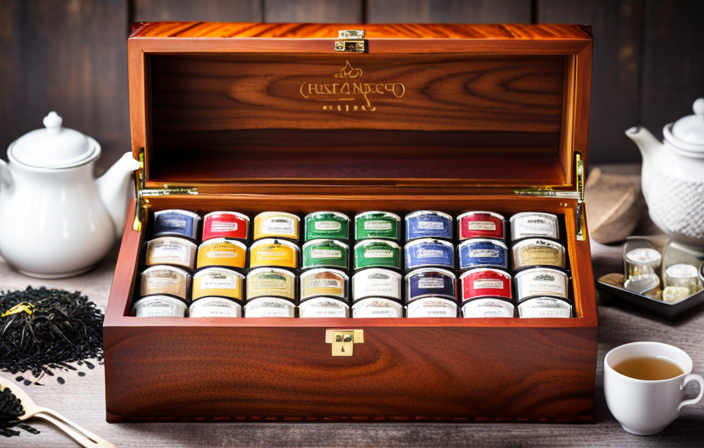I’ve brewed countless cups of tea, and I’ve learned that the key to preserving its freshness and flavor lies in proper storage.
In this article, I’ll share the best practices I’ve discovered – from using airtight containers to avoiding heat and light exposure.
I’ll also explain why it’s crucial to keep your tea away from strong odors and why freezing or refrigerating it can be detrimental.
Join me as we delve into the science behind tea storage and unlock the secrets to serving the perfect cup every time.
Key Takeaways
- Storing tea in airtight containers is essential for preserving its freshness and flavor.
- Tea should be kept in cool and dark environments to avoid heat, light, and humidity exposure.
- Strong odors should be avoided to prevent flavor contamination and maintain the natural aroma of tea.
- Proper storage practices, such as using airtight containers and dark, opaque containers, prevent contamination and preserve the color and aroma of tea.
The Impact of Airtight Containers on Tea Freshness
I think using airtight containers helps maintain the freshness of tea longer. The impact of moisture on tea quality can’t be underestimated. When tea leaves are exposed to moisture, they can absorb it, leading to a decrease in flavor and aroma.
That’s why it’s essential to store tea in vacuum sealed containers. These containers create a barrier that prevents moisture from seeping in, keeping the tea leaves dry and preserving their quality. Vacuum sealing not only protects the tea from moisture but also from other external factors that can affect its freshness, such as air and odors. By utilizing vacuum sealed containers, tea enthusiasts can ensure that their tea stays fresh and flavorful for a longer period of time.
Now, let’s discuss another crucial aspect of tea storage: avoiding heat and light.
Avoiding Heat and Light: Essential Factors in Tea Storage
To maintain the freshness and flavor of tea, it’s important to store it in a cool and dark place. This helps protect the tea from moisture and prevents exposure to light, both of which can have a detrimental effect on its quality.
Humidity, in particular, plays a significant role in tea storage. Too much humidity can cause the tea leaves to absorb moisture, leading to mold growth and a loss of flavor. On the other hand, low humidity can result in the leaves drying out and becoming brittle. Striking the right balance is key.
Storing tea in a cool and dark environment helps maintain optimal humidity levels and ensures that the tea retains its freshness and flavor for longer.
Now let’s discuss another important aspect of tea storage: keeping it away from strong odors and why it matters.
Storing Tea Away From Strong Odors: Why It Matters
Storing tea away from strong odors is crucial for maintaining its quality and flavor. Odors from other foods or spices can easily permeate the tea leaves, resulting in a loss of its natural aroma.
Odor Affects Tea Quality
The odor of surrounding items can negatively impact the quality of the tea. When it comes to storing tea, preventing flavor contamination is crucial. The aroma of other substances can easily infiltrate tea leaves, altering their taste and diminishing their freshness. To help you preserve the true essence of your tea, here are some essential tea storage tips:
| Tip | Description |
|---|---|
| 1. | Store tea in airtight containers |
| 2. | Keep tea away from strong odors |
| 3. | Store tea in a cool, dry place |
Proper Storage Prevents Contamination
I make sure to store my tea in airtight containers and keep it away from strong odors because proper storage prevents contamination and ensures the freshness of my tea. When it comes to preserving the quality of tea, preventing bacterial growth and maintaining its natural color are crucial.
Bacteria can thrive in moist environments, which is why it’s important to store tea in airtight containers. This prevents moisture from seeping in and creating an ideal breeding ground for bacteria. Additionally, exposure to strong odors can taint the flavor of tea, so I keep my tea away from any strong-smelling substances.
Furthermore, maintaining the natural color of tea is essential for an appealing and enjoyable experience. Light and air can cause tea to lose its vibrant color, so I store it in dark, opaque containers to shield it from these elements.
Preserve Tea’s Natural Aroma
To maintain the natural aroma of tea, I always ensure it’s stored away from any potent scents. Preserving tea’s natural aroma is crucial to enjoy its full flavor and freshness. Here are four best practices for storing tea and locking in its freshness:
-
Store in an airtight container: Oxygen, moisture, and light can degrade tea quality. Use airtight containers to keep these elements out and preserve the tea’s natural aroma.
-
Keep away from heat: High temperatures can cause tea to lose its flavor and aroma. Store tea in a cool, dry place away from direct sunlight or heat sources like stoves or ovens.
-
Avoid strong odors: Tea leaves are porous and can absorb surrounding odors easily. Keep tea away from strong-smelling substances like spices, coffee, or cleaning products.
-
Use opaque containers: Light can degrade tea quality, so choose containers that are opaque or keep tea in a dark cupboard to protect it from light exposure.
Why Freezing and Refrigerating Tea Is a Bad Idea
Freezing and refrigerating tea may seem like a convenient way to extend its shelf life, but it can actually harm the quality and flavor of the tea. When tea leaves are exposed to extremely low temperatures, it can cause moisture to form, leading to the degradation of the leaves.
Additionally, the fluctuations in temperature that occur when removing and returning the tea to the freezer or refrigerator can introduce moisture and compromise the flavor.
Temperature Affects Tea Quality
The temperature of the water used to brew tea greatly impacts its overall quality and taste. Here are four key points to consider when it comes to temperature regulation in tea brewing:
-
Optimal Temperature: Different types of tea require different water temperatures. For delicate green and white teas, a lower temperature of around 175°F (80°C) is recommended to prevent bitterness. Black teas, on the other hand, benefit from hotter water around 205°F (96°C) to fully extract their flavors.
-
Impact of Humidity: Humidity can affect the quality of tea leaves. Exposure to high humidity can lead to moisture absorption, resulting in a loss of flavor and aroma. It’s essential to store tea in a cool, dry place to preserve its freshness.
-
Heat Retention: Using a well-insulated teapot or infuser can help maintain the desired water temperature for a longer period. This ensures that the tea leaves are properly steeped and the flavors are fully extracted.
-
Water Quality: The quality of the water used for brewing also plays a role in the tea’s taste. Filtered water or spring water is recommended to avoid any unwanted flavors or impurities.
Understanding the impact of temperature on tea brewing is crucial for achieving the perfect cup of tea. However, it’s not just the temperature that affects tea quality; moisture ruins tea leaves by diminishing their flavor and aroma.
Moisture Ruins Tea Leaves
I’ve learned that moisture ruins tea leaves, so I always make sure to store mine in a dry place.
The impact of moisture on tea freshness is significant. When tea leaves are exposed to moisture, they can absorb it, leading to the growth of bacteria and mold. This not only affects the taste and aroma of the tea but also poses health risks.
To prevent moisture in tea storage, it’s essential to keep tea leaves away from humid environments, such as the kitchen or bathroom. Instead, store them in airtight containers in a cool and dry place. Airtight containers prevent oxidation, which can also degrade the quality of tea leaves.
Airtight Containers Prevent Oxidation
I always make sure to store my tea in airtight containers to prevent oxidation and maintain its freshness and flavor.
Here are four best practices for storing tea to preserve its flavor:
-
Choose the right container: Opt for airtight containers made of glass or ceramic to keep air and moisture out. Avoid plastic containers as they may retain odors and affect the taste of the tea.
-
Store in a cool, dark place: Heat, light, and humidity can accelerate the oxidation process and degrade the flavor of tea. Find a cool, dark spot in your pantry or cupboard to keep your tea at its best.
-
Keep away from strong odors: Tea can easily absorb surrounding odors, so it’s important to store it away from strong-smelling foods or spices. This will help preserve its natural aroma and taste.
-
Use individual portion sizes: Instead of repeatedly opening a large container, divide your tea into individual portion sizes. This minimizes exposure to air and maintains the freshness of each serving.
Understanding the Effects of Heat on Tea Flavor
As a tea enthusiast, I’ve noticed how heat can significantly alter the flavor profile of different tea varieties. Heat plays a crucial role in tea oxidation, which is a natural process that occurs when the tea leaves are exposed to air. When tea is stored in cool environments, oxidation is slowed down, preserving the freshness and flavor of the tea.
High temperatures, on the other hand, can speed up the oxidation process, resulting in a change in taste and aroma. It’s important to store tea in a cool and dark place, away from direct sunlight and heat sources, to protect its delicate flavors.
Now, let’s delve into the role of light in tea degradation and explore how to best protect your tea from its harmful effects.
The Role of Light in Tea Degradation and How to Protect Your Tea
To truly understand the impact of light on tea degradation and effectively protect your tea, it’s essential to implement proper storage techniques. Here are four key factors to consider in protecting tea from sunlight and preserving its freshness and flavor:
-
Light exposure: Sunlight can cause tea leaves to lose their flavor and aroma. To prevent this, store your tea in opaque containers or tins that block out light.
-
Location: Choose a cool, dry, and dark place to store your tea. Avoid placing it near windows or other sources of direct sunlight.
-
Humidity control: Tea is sensitive to moisture, so it’s important to store it in a place with controlled humidity. Too much moisture can lead to mold growth, while too little can make the leaves brittle.
-
Air-tight containers: Using air-tight containers helps to maintain the freshness of your tea by preventing exposure to air, which can cause oxidation and loss of flavor.
The Importance of Keeping Tea Away From Strong Odors
Avoiding strong odors is crucial for maintaining the freshness and flavor of tea. When tea is exposed to strong odors, it can easily absorb them, resulting in a compromised taste and aroma. To ensure the best quality of tea, it is important to store it in airtight containers that are made of materials that do not release any odors. The type of packaging material used can have a significant impact on tea freshness. For example, glass jars with tight-fitting lids or metal tins are excellent options as they are odorless and help to preserve the tea’s flavor. Additionally, humidity plays a vital role in tea preservation. Excessive moisture can cause tea leaves to become damp, leading to mold growth and a loss of flavor. Therefore, it is important to store tea in a cool and dry place to maintain its freshness and flavor.
| Packaging Material | Impact on Tea Freshness |
|---|---|
| Glass jars with tight-fitting lids | Excellent at preserving flavor |
| Metal tins | Odorless and effective in maintaining freshness |
| Plastic containers | Can retain odors and affect taste |
| Paper bags | Not ideal for long-term storage |
Frequently Asked Questions
How Long Can Tea Be Stored Before It Starts to Lose Its Freshness and Flavor?
Tea can start losing its freshness and flavor after being stored for a certain period of time. The length of time varies depending on factors such as the quality of the tea and how it’s stored.
It’s important to know how to properly store loose leaf tea to maintain its freshness. Additionally, the quality of water used can also affect the freshness of stored tea.
Can I Store Different Types of Tea Together in the Same Container?
Yes, you can store different types of tea together in the same container. However, it’s important to choose tea storage containers that are airtight and keep out moisture, light, and strong odors. This will help preserve the freshness and flavor of each tea.
It’s also a good idea to label the containers to avoid any mix-up. Storing tea together can be convenient, but proper storage conditions are crucial for maintaining its quality.
Is It Necessary to Store Tea in a Specific Temperature Range to Maintain Its Quality?
Maintaining the quality of tea is crucial, and proper storage plays a significant role in this. Storing tea in a specific temperature range is indeed necessary to preserve its flavor and freshness. Temperature fluctuations can accelerate the degradation process, leading to a loss of aroma and taste.
Therefore, it’s important to store tea in a cool, dry place away from heat sources to ensure its quality is maintained.
Can I Store Tea in Glass Containers Instead of Airtight Containers?
I think storing tea in glass containers has its pros and cons.
On the one hand, glass containers allow you to visually appreciate the beauty of the tea leaves and can add a touch of elegance to your tea storage.
However, glass containers aren’t as airtight as other options, which may compromise the freshness and flavor of the tea over time.
If you’re looking for alternatives to airtight containers, you could consider using ceramic jars or tin canisters, which provide better protection against air and moisture.
What Are the Signs That Tea Has Gone Bad and Should No Longer Be Consumed?
When it comes to tea, it’s important to know the signs of spoiled tea and how to properly store it to prevent spoilage.
Signs of spoiled tea include a musty or sour smell, a change in color, or the presence of mold.
To preserve tea’s freshness and flavor, it’s best to store it in an airtight container, away from light, heat, and moisture.
This will help maintain its quality and ensure a delightful cup of tea every time.
Conclusion
In conclusion, proper storage is crucial for preserving the freshness and flavor of tea. Airtight containers, avoiding heat and light, and keeping tea away from strong odors are essential practices.
Freezing and refrigerating tea should be avoided, as they can negatively impact its quality. Understanding the effects of heat and light on tea is vital to maintaining its flavor.
By following these best practices, you can ensure that your tea remains delicious and enjoyable for a longer period of time.










